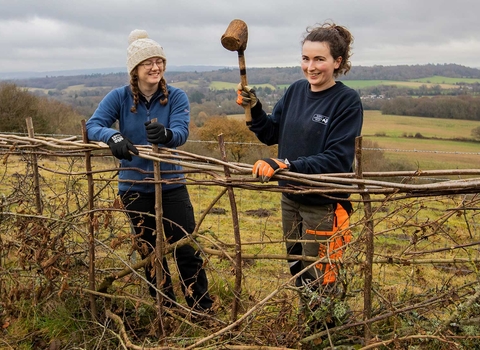What makes a hedgerow ?
Hedgerows are a dynamic and complex entity, formed by a series of components that, if well managed, contribute important resources to wildlife.:
- Hedgerow tree layer Over half of our priority species associated with hedgerows depend on hedgerow trees, especially oak, ash or beech that has been allowed to reach a more mature stage. Unfortunately, we are seeing a loss of hedgerow trees and also a lack of new trees; we are seeking to address this by planting new hedgerows. Smaller trees like Rowan and crab apples also provide valuable sources of food.
- Shrub layer – Hedgerows with greater diversity within the shrub layer support and provide food for a higher diversity of species. It is best if these shrubs are native species (as with the tree layer) as they provide a better habitat for insect and animal species that have adapted to eat them.
- Base layer – Maintaining a dense base layer is crucially important to wildlife as it provides shelter and refuge, particularly for species using hedges to migrate or for nesting. Should this layer become too sparse, laying the hedge can help restore density.
- Hedge Margin – Despite not physically a part of the hedge itself, this component is valuable for a variety of reasons. Larger margins between the base of the hedge and a source of disturbance, such as a foot path, offer more protection to roots of the shrubs and trees within the hedgerow. The herbaceous wildflowers and grasses that grow in this margin offer protection from drifting spray or fertilisers, as well as providing valuable habitat
What are the benefits of hedgerows to wildlife and people?
Much of our wildlife is supported by hedgerows providing food and shelter during their life cycle – for instance did you know that 80% of woodland bird species call a hedgerow home? Berries provide autumn and winter resources for birds such as the redwing, and nuts sustain the hazel dormouse. Flowers provide sources of nectar for pollinators which in turn support birds, reptiles, mammals and other invertebrates. Shelter is also provided for breeding activity over the late spring and summer months as well as refuge during the winter. Hedges with a thick base layer and lots of ground flora provide good habitat for bees to hibernate over winter, whilst hedges with fully grown trees, particularly with dead wood, provide good roosting habitat for bats. Hedgerows also connect habitats, providing safe wildlife corridors for species to use as ‘highways’ in order to access other habitats.
Hedgerows offer us a variety of services. A new hedgerow can annually absorb the carbon produced by a car travelling over 1000km. Hedges also purify air by producing oxygen and reduce the risk of flooding by increasing infiltration rates and slowing water flow – which in turn provides a steady supply of water for crops.
Hedgerows also offer us cultural services, telling a story of humans’ historic interactions with the land, providing educational opportunities and acting as aesthetically pleasing landscape features which can benefit people’s mental wellbeing. You may also still spend a recreational late summer’s day out picking berries to gather fruit like blackberries andsloe berries for traditional baking recipes – definitely providing a positive experience for our taste buds.
How can I help?
You may be asking yourself ‘how can I help?’. Well, our Hedgerow Heritage project aims to inspire and engage people of all ages and abilities in hedgerow management. You can become a volunteer to help survey the hedges within the North Downs project area – or further afield within Surrey – over the summer months. In winder, you can join our hedge laying and hedge planting volunteer sessions.
People under 25 can join our weekend hedge laying events throughout autumn and winter too. If you’re a keen hedge layer already, look out for February competitions!
Landowners can also seek further advice from our project management team about management techniques and accessto government grants.
If you’re reading from outside Surrey, you can still help. The People’s Trust for endangered species is building a picture of the current state of hedgerows across the UK via a ‘Great British Hedgerow Survey’. Hedgelink is running a ‘National Hedge Week’ in September 2022; you can celebrate and help build awareness about hedgerows through their TalkToTheHedge interactive guide.
You can also help out by volunteering with your local Wildlife Trust, RSPB or National Trust. There is so much to explore about hedgerows, and I hope this has helped inspire you to get involved.



